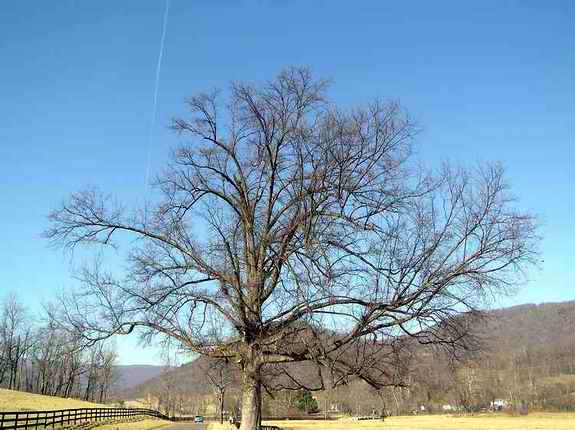|
Common Name: White Oak, Stave Oak (due to widespread use for barrel staves) Scientific Name: Quercus alba (Generic name is Latin for Oak; alba is Latin for white)
The white oak is the predominant member of the white oak subgenus Leucobalanus (meaning white acorn) that includes the post oak (widely used for fence posts), the chestnut oak (the leaves look like those of chestnut trees), and the chinquapin (or chinkapin) oak (the leaves look like those of chinquapin trees), among others. It is a massive tree that grows vertically to a height of about 100 feet, and, when in the open, forms branches up to 50 feet long at right angles to the trunk. The white oak group is characterized by leaves that have rounded lobes, bark that is light gray in color and can be peeled off in flakes, and acorns that are low in tannin and mature in one year. The white oaks hybridize readily and therefore display a high degree of genetic variability.
White oak acorns are an important food source for many animals; however, their consumption detracts from the profligacy of the parent tree. To counteract this, the white oak produces good acorn crops at erratic intervals, an evolutionary mechanism known as masting. These intervals can vary from 3 to10 years according to various environmental factors. Limiting acorn production keeps the seed consuming population at a relatively low level so that during a mast year, there are more acorns than can be consumed. One study found that a single 69 foot tall oak tree produced 23,000 acorns in a single mast year. Several studies have found that animals consume between 72 and 83 percent of the acorns, the entire crop being eliminated in a non-mast year. On the other hand, blue jays and gray squirrels are largely responsible for the dispersal of white oaks, as they bury the acorns in open spaces away from the shade of the parent tree. White oak acorns were one of the most important foods for eastern Native American tribes. They were beaten into a powder, leached to remove the bitter taste and cooked into a variety of staple foodstuffs.
White oak wood is hard, strong and durable; a valuable timber tree with many commercial uses. Its use for the staves of barrels and buckets and as a ship-building wood is due to its resistance to water penetration This characteristic is attributed to a plastic-like substance named tyloses that plugs the sapwood vessels to block the movement of water and fungal spores. It is one of the premier woods used in the manufacture of furniture, paneling, veneer, and the aptly named hardwood floors. Its use for railroad ties, mine timbers and fence posts is testimony to its strength and reliability. It has a high fuel value and is one of the best sources of firewood. However, white oak regenerates poorly after a timber harvest.
White oak trees are regenerated by both seed and vegetative means. The acorn seeds of white oak do not store well, having longevity of less than one year. Their viability decreases from 90 percent when fresh to 7 percent after only 6 months. Acorns germinate soon after falling from the tree as long as the ground has adequate leaf litter and there are not too many consuming animals. White oaks readily regenerate vegetatively from the stumps of smaller saplings, 80 percent for trees up to 5 inches in diameter. However, 12 inch trees only sprout 15 percent of the time. Forest management is therefore required for a sustained tree harvesting operation, cutting only 60 percent of the full grown trees and planting about 400 saplings per acre.
White oak bark tannin has historically been used medicinally to treat a wide variety of ailments. The bark was collected in the early spring, dried and chopped into a fine powder and boiled in water to make a tonic decoction. The liquid could then be used as a gargle to soothe sore throats or applied topically to treat bleeding gums. It was also used as a bath to treat chilblains and frostbite and as a poultice to treat hemorrhoids and hernias. A stronger decoction was made by further boiling of the liquid into syrup to control diarrhea. Powdered bark was inhaled through the nose to stop nosebleeds, sprinkled onto bed sheets to prevent bedsores, and mixed with honey to reduce menstrual cramping. Acorn powder was mixed with milk as an antidote to poisonous herbs and added to wine as a diuretic. In Germany, a related white oak species is approved for use as a treatment for inflammatory skin diseases.
Many cultures and peoples have attributed superstitious and magical powers to the white oak. This is in part due to the fact that it is often stuck by lightening due to its size and relatively low electrical resistance. It has been associated with the gods of thunder, notably the Greek Zeus and the Norse Thor whose magical hammer Mjolnir was purportedly made by dwarves from a sacred oak tree. The druids used the oak as a means of divining the nature of the next growing season. Acorns were placed on window ledges to guard against lightening strikes and carried in the pocket to aid longevity, magically imparting the venerability of the oak. Young women would place two acorns in a bowl of water; if they moved together, it was an indication that they had found true love.
|
